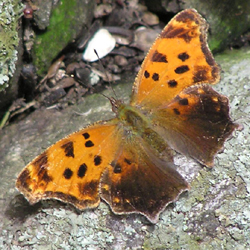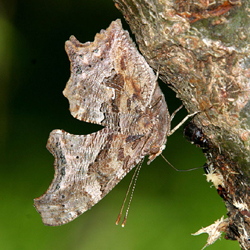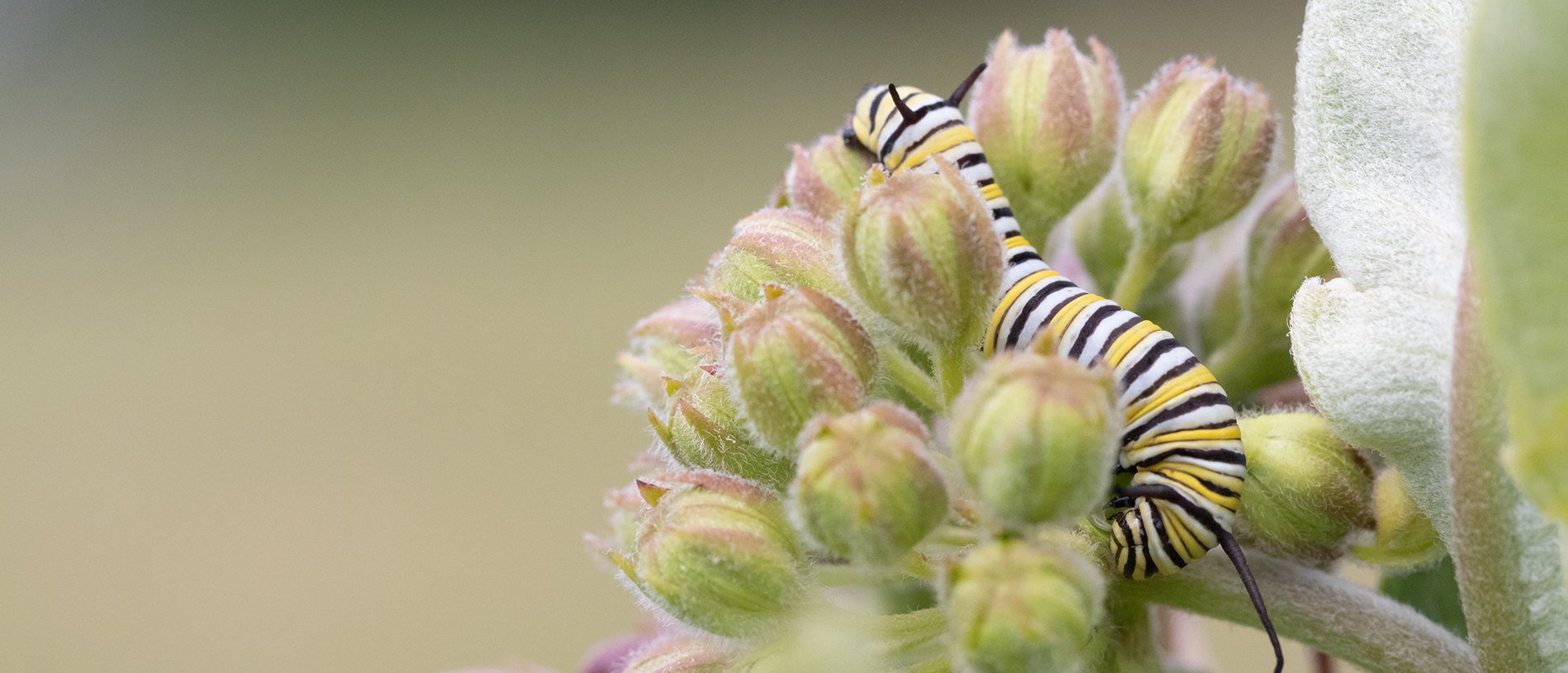Find a Butterfly
Eastern Comma
Polygonia comma
Named
Harris, 1842

Identification
Wingspan: 1 3/4-2". The Eastern Comma, in common with other "anglewings", has pronounced indentations along the wing margins. It can be told from the Question Mark by its smaller size, more ragged wing outline, and "comma" on the underside of each hindwing; from the Gray Comma by the "comma" shape and by overall ventral coloration (see under Gray Comma). Two color forms exist in Massachusetts: the summer form has dark upper hindwings and violet edging to the wings, and the winter form has uniformly orange-colored wings above.
Distribution
Southeastern Saskatchewan east to maritime Canada and south to central Mexico and the Gulf states. Rarely found in central Colorado, Newfoundland, and Cuba. Eastern Commas occupy the southern two thirds of New England.
Status in Massachusetts
At the turn of the century, Scudder characterized the Eastern Comma as rather local and uncommon in New England, except in the very southernmost areas. He was familiar with the insect from most of Massachusetts, from the general vicinity of Boston north and west. Scudder lists no records from southeasternmost Massachusetts (and there are none in the MCZ, Harvard University). In addition, there are a mere handful of historical records from Martha‘s Vineyard and Nantucket. During the Atlas period, the Eastern Comma was found to be generally distributed throughout the state, with the exception of southeastern counties, where it was only rarely encountered. It is usually met with singly, rarely in abundance. Maximum: 12, on 5 July 1987, Uxbridge (Worcester Co.).

Flight Period in Massachusetts
Summer form: late June (slightly earlier in the southern Connecticut Valley) to late August. Winter form: early September to early November and late March through May. Hibernating adults may emerge for brief periods during winter warm spells. Extreme dates: 23 March 1994, Easton (Bristol Co.), K. Ryan and 4 December 1994, Foxboro (Norfolk Co.), B. Cassie.
Larval Food Plants
American Elm (Ulmus americana), Stinging Nettle (Urtica dioica), False Nettle (Boehmeria cylindrica), Wood Nettle (Laportea canadensis), and Hops (Humulus lupulus), are documented common larval food sources that occur in Massachusetts.
Adult Food sources
The Eastern Comma rarely visits flowers, feeding instead at fermenting fruit, tree sap, and animal droppings. Recorded nectaring at Common Milkweed, Joe-Pye-Weed, and Smooth Sumac by Atlas workers.

Habitat
Throughout its range, from sea level to moderate elevations, the Eastern Comma is associated with rich deciduous woodlands. It occupies forest clearings, sunny spots along woodland roads, and open areas in the vicinity of its food plants, not uncommonly in close proximity to buildings. Lack of suitable woodlands probably account for its scarcity in southeastern Massachusetts.
Life Cycle
EGG: Pale green: barrel shaped, with about 11 vertical ribs. OVIPOSITION: Eggs laid in columns, with two to nine eggs per column, on the underside of the host plant‘s developing leaves. LARVA: Exceedingly variable in color; both the larval body and its ornament of branched protective spines range in color from white through green to black. Late instar caterpillars construct a nest from the drawn in edges of a host plant leaf. CHRYSALIS: Pale brown, with light green streaked markings. OVERWINTERING STAGE: Adults seek shelter for the winter in tree cavities, under bark or shingles, or in similar snug areas out of the elements. In Massachusetts and the Northeast, the Eastern Comma is double brooded. Overwintering adults emerge during the first warm days of spring, warming themselves with outstretched wings on a sunny rock or tree stump. Spring larvae grow comparatively slowly, living and feeding singly. Pupation lasts from seven to eleven days. The summer darkly colored form of the Eastern Comma first appears around the summer solstice and individuals may be observed through August, when they give way to the next generation, orange winged and violet tinged. Fall Eastern Commas stay on the wing until quite late in the year, and judging by the fresh condition of some butterflies seen as late as early November, a number probably do not eclose from the chrysalis until late September or later.
Eastern Commas are territorial and pugnacious and will fly at any butterflies or other large insects that "invade" the sunny patches serving as their territories. Owing to their erratic flight and the dappled lighting of their preferred habitat, they are often difficult to follow in flight.
Notes
In earlier years, farmers growing Hops are said to have used the brilliant metallic markings on the Eastern Comma‘s chrysalis (which they found in numbers on their crop) to forecast the season‘s prices: if the markings were golden, the Hop prices would be high; if they were silver, the prices would be lower. Hence, the derivation of the species‘ other common name, Hop Merchant.
Account Author
Brian Cassie



